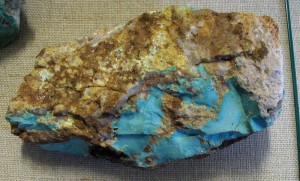Determining turquoise value is a somewhat complicated process. There are so many factors contributing to turquoise value, including age, hardness, purity and the mine the stone was pulled from – to name just a few. Here’s a few of the primary methods used to determine turquoise value.

Turquoise Value: The Mine
For hard-core collectors and enthusiasts, the mine is always a determining factor. Americans prize turquoise from mines in the Southwestern United States, particularly those in Nevada and Arizona.
Turquoise value will rise significantly if the stones are from a mine that has ceased producing stones or one that is not producing enough to be considered commercially viable.
The Sleeping Beauty, Kingman and Bisbee mines are good examples of turquoise value that is largely influenced by the mine where the stones were harvested.
Turquoise Value: Purity
Not every stone that comes from the ground is ready for use in jewelry and art. In fact, it is relatively rare that stones are discovered that don’t require any form of stabilization or treatment before they are ready for the market.
Yet some stones are stable and hard enough to be polished and put on the market straight out of the mine and these are among the most valuable. Typically, stones may be injected with resins to improve stability and ensure the color won’t deteriorate quickly.
Turquoise is not among the hardest stones and straight out of the ground it can look porous and grainy, even to the naked eye. Professional stoneworkers are adept at treating turquoise in a way that improves strength while maintaining as much purity as possible.
Turquoise Value: Color
Color-based turquoise value will vary depending on what part of the world you happen to be in. American collectors often prize stones with interesting and uncommon combinations of color and matrix as well as pure blue varieties such as Seeping Beauty.
In other parts of the world however, turquoise value is based almost exclusively on the purity and sky blue color. Veining, matrix or green-to-brown coloration may be seen as a flaw to some collectors outside of the United States.
Turquoise Value: Age
Many collectors look for stones and jewelry that was mined and processed long ago. In fact, there’s an entire market around vintage and “old pawn” turquoise jewelry. Unfortunately, these markets are packed with scammers passing off fraudulent versions of this jewelry, so it’s always better to go with a reputable dealer if you are in the market for this style.